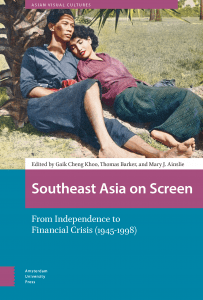sGraduate School faculty member Prof. Joyce Arriola’s work was recently published as a chapter in a book anthology released by the Amsterdam University Press.


The book titled “Southeast Asia on Screen: From Independence to Financial Crisis (1945-1998)” was edited by Gaik Cheng Khoo (University of Nottingham Malaysia), Thomas Barker (University of Nottingham Malaysia) and Mary Jane Ainslie (University of Nottingham Ningbo China) and featured scholars from Malaysia, Philippines, Australia, Vietnam, Indonesia and Singapore. From a historical perspective, the book tackles the rise of post-war cinemas from Southeast Asia, how these negotiate colonial influence, and build national expressions throughout the different political regimes until the Asian financial crisis of the 1990s.
Arriola, who also teaches at the Faculty of Arts and Letters, wrote a chapter contribution titled “The 1950s Filipino Komiks-to-Film Adaptation during the Studio Era” is placed under the first section of the book titled “Independence and Post-World War II Filmmaking: Nation-building, Modernity and Golden Eras.” The said chapter tackles how post-war Philippine film industry rose from the devastation caused by the Second World War through the revitalization of the studio system that had been in place before the breakout of the war. The four major film studios of the 1950s – LVN, Sampaguita, Premiere and Lebran – each took a particular genre or two where they could specialize.
The studios also collaborated harmoniously with the komiks industry – then featured in both mixed-format magazines and in dedicated publications – which became the steady supplier of materials for the film industry. Stories from the komiks were drawn from korido (metrical romance), historical events, personages, popular culture, and true events.
Arriola argues that David Forgacs’ idea of “national-popular” may be applied on the synergistic relationship between the komiks industry and the film industry.
Adaptations became the instrument for nationalizing creative expressions, even if the source materials were foreign and colonial. They created, in the process, a formative realization of vernacular modernism wherein the new technology of modernity (cinema) is vernacularized or localized.
The book “Southeast Asia on Screen” is part of the Asian Visual Cultures series spearheaded by Amsterdam University Press, which is one of the top academic presses in the world today.
The publication project took almost two years and invited scholars from Southeast Asia who could best articulate the rise, growth, problems and potential of post-war Southeast Asian cinemas.
Considered as an important contribution to a more specific and detailed study of Southeast Asian cinema, the book trains its lens on the impact of the nationalist movements on Southeast Asian cinemas; the struggle with different political ideologies and cultures; the influence of the West upon the form and genres of film products; the impact of the Asian financial crisis on the rise of independent cinema; and, the promise brought by digital technology and the new contexts around which emergent filmmakers built their fresh creative expressions.
Arriola’s work on the 1950s film adaptation culture has been part of her long-running interest in adaptation studies and adaptation theory. In 2019, she released her second book on adaptation titled Pelikulang Komiks: Toward a Theory of Filipino Film Adaptation (University of the Philippines Press). According to Ms. Anna Rita Alomo, Acquisitions Librarian of UST Miguel de Benavides Library, the book Southeast Asia on Screen: From Independence to Financial Crisis (1945-1998) may be accessed through the Cambridge eBooks platform through the following link: https://bit.ly/DrArriolaKomiks




